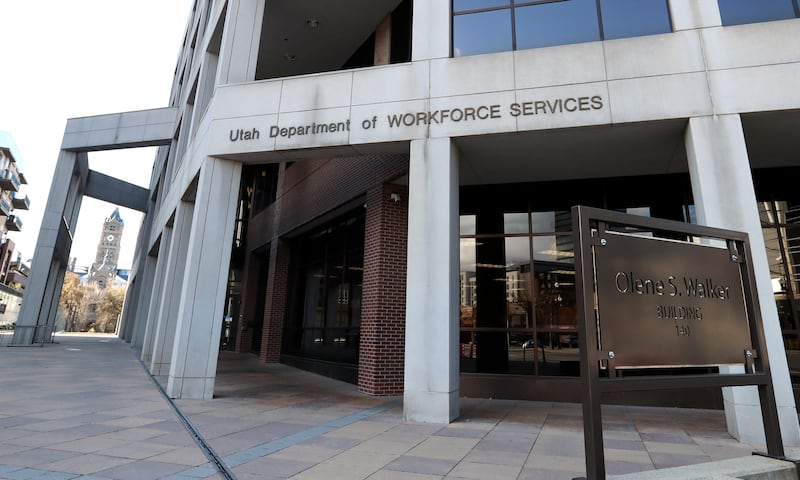SALT LAKE CITY — Despite a significant decline in new people filing for unemployment last week, the number of Utahns seeking benefits remains historically high.
The state Division of Unemployment Insurance reported Thursday that 9,057 individuals filed new claims for unemployment benefits in Utah during the week of April 26 to May 2 — a 23% decrease from the prior week when 11,830 people filed new claims. This week’s report shows a total of 107,711 Utahns seeking help, with nearly $26 million paid out in traditional benefits.
The numbers reflect record volume brought on by the COVID-19 pandemic, the department notes. The average number of weekly claims last year was 1,331.
The division reported an additional $47 million in $600 weekly stimulus payments were distributed to Utah’s unemployed — resulting in $73 million in overall unemployment benefits for the week. A total of 4,166 new Pandemic Unemployment Assistance claims were also submitted.
“We are grateful for everyone that has continued to be patient as the incredible staff process this record volume of claims and meet this demand,” said Kevin Burt, director of the Unemployment Insurance Division. “With the state moving to the orange moderate risk factor, we remind claimants returning to work to accurately report wages earned during your weekly claim.”
For the week, the industries with the highest percentage of claims were office and administrative support at 13%, sales and related occupations at 11%, and food preparation and serving at 7%. The counties reporting the highest number of individuals filing new unemployment insurance claims were Salt Lake County at 40%, Utah County at 13%, Davis County at 9%, Weber County at 7% and Washington County at 4%.
While claims have decreased four consecutive weeks, there continues to be historic volume, Burt said.
“To try and help provide some perspective, since March — which is about 45 days from March 15 to May 2 — the Department of Workforce Services has received 146,000 unemployment claims,” he said. “During those three years previous, so all of 2017, 2018 and 2019 combined, the department received 195,000 claims.”
He noted that the downward claims trend is a positive sign, but a great number of Utahns continue to access jobless benefits and services.
“Last week we processed almost $73 million in benefits,” he said. “Again, for some historical perspective, in 2019, the average benefit processed in a week was about $3 million.”
Burt also pointed out a distinction between the dollars the state pays out and the money distributed by the U.S. government.
“It is important also to recognize, especially when we’re looking at the (state’s) trust fund solvency, that we separate out what is paid for out of the trust fund versus what is paid for out of the federal stimulus benefits,” he explained. “So of that $73 million, about $26 million was paid for out of the state trust fund, and almost $47 million was paid for with the stimulus benefit.”
Also of note was the amount in benefits paid out last week to individuals who applied for pandemic unemployment assistance that became available on April 15. — just over $1.6 million in benefits, more than 1,000% more than the week before, he said.
“It’s incredible to see the amount of work being done by our partner agency — the Workforce Development Division — in processing these claims,” Burt said Thursday during his weekly media availability. “It’s also important to remember as we’re getting through this Pandemic Unemployment Assistance application, it is a new program with the (Coronavirus Aid, Relief and Economic Security) Act that is opening up assistance to those not eligible for unemployment such as those that are self-employed or gig workers.
“In fact, the last number I saw (is) over 20 states had still not stood up an application for people to apply for the pandemic unemployment assistance. So with our partnership with the Workforce Development Division, not only have we been able to stand up that application from scratch, we’ve also been able to process $1.6 million in benefits to these individuals that are on pandemic unemployment assistance.”
Burt said the state is working diligently to help individuals access the resources they need to weather the COVID-19 crisis, but officials are cautiously optimistic that as time passes and more people are able to resume some normal activities, then the urgent need for those financial benefits will diminish.
“What we do hope with the pandemic that is different than in a regular recession is that during a recession, people are laid off and there is no opportunity to return to those employers,” he said. “During the pandemic, what we hope is some restrictions have paused the economy, but as those restrictions are lifted as we moved into the orange status, we’ll be able to see a lot of people return to their former employer. And as quickly as they came on, they fall off with the unemployment benefits as they’re able to return to work.”
Across the nation, nearly 3.2 million laid-off workers applied for unemployment benefits last week as the business shutdowns caused by the viral outbreak deepened the worst U.S. economic catastrophe in decades. The Associated Press reported roughly 33.5 million people have now filed for jobless aid in the seven weeks since the coronavirus began forcing millions of companies to close their doors and slash their workforces. That is the equivalent of 1 in 5 Americans who had been employed back in February, when the unemployment rate had reached a 50-year low of just 3.5%.
The Labor Department’s report Thursday suggests that layoffs, while still breathtakingly high, are steadily declining after sharp spikes in late March and early April. Initial claims for unemployment aid have now fallen for five straight weeks, from a peak of nearly 6.9 million during the week that ended March 28.


